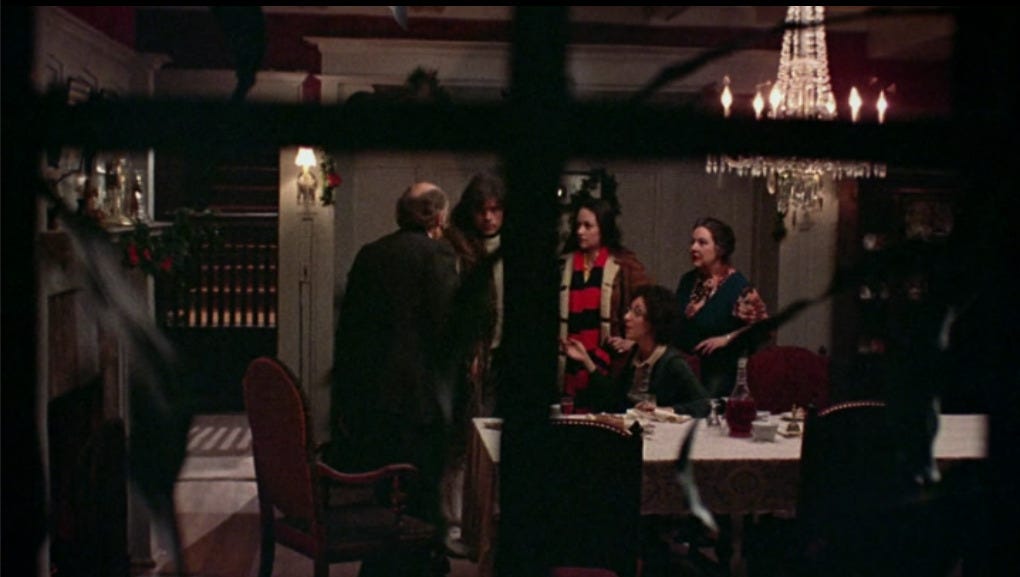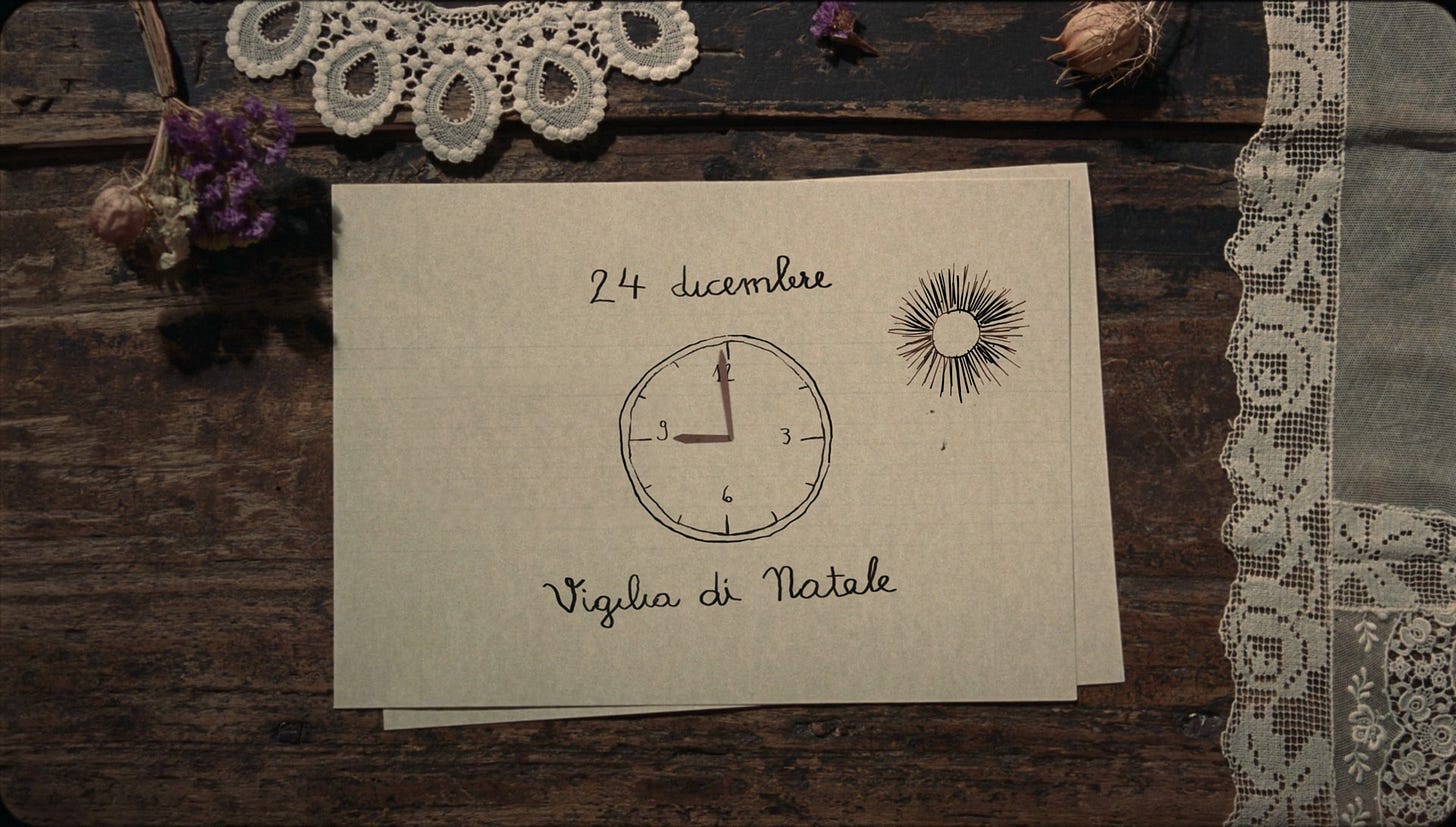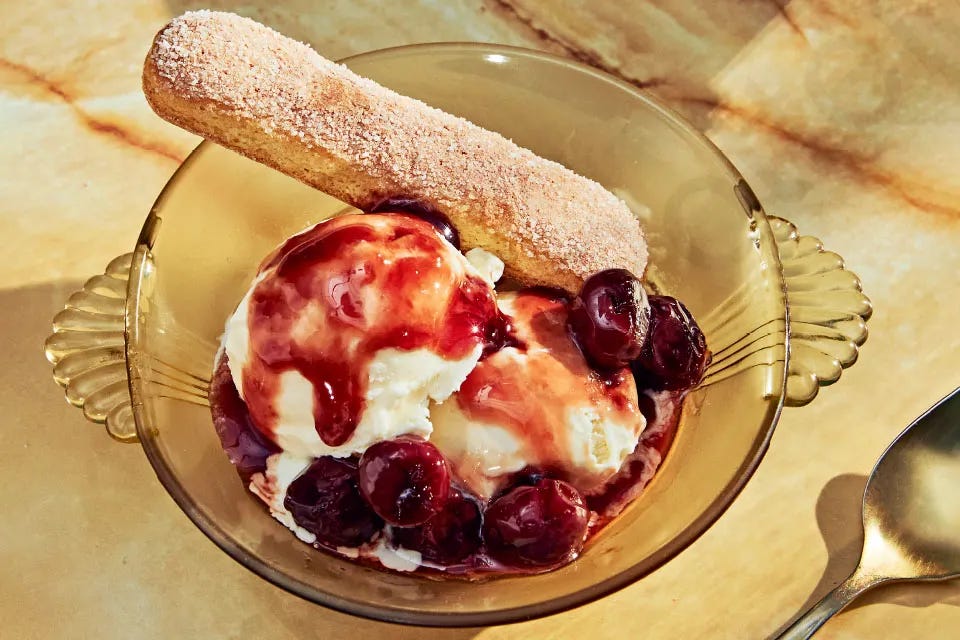My ideal weather is low 30s, hazy skies, mostly dry, the day before a snowstorm when the vapor chill hasn’t set in, so I’m not entirely in my element come December, or a particularly festive mood, thanks to the environmental shifts and the continuing climate crisis that have forestalled any chance of a white Christmas. The family tradition is watching Bad Santa, and if the overabundance of sugar cookies hasn’t gotten me in the festive spirit by then, Billy Bob Thornton’s Bukowsking surely will.
I’ll keep this short. Here are a a few “Christmas movies,” in setting only, to watch at home as alternate programming. If you’re going to the theaters, bliss out on Michael Mann’s Ferrari obviously. Happy holidays. I’ll be back next week with the best movies of the year.
SHORT TAKES
Sorority sisters start dropping like flies while gearing up for winter break in BLACK CHRISTMAS (1974). Bob Clark’s cult classic—one of the first slasher films—delivers unexpectedly progressive views on abortion and pregnancy and real chills amidst the yuletide setting. Streaming on Peacock and Tubi.
The clunky 2019 remake starring Imogen Poots supercharges the girl-power quotient amidst a campus assault context, but makes the dire mistake of eradicating all the mystery and suspense. I’m not sure the 2006 remake is any better, but I’m about to find out. Streaming on Netflix.
The ugliness of humanity—xenophobia, hypocrisy, and the like—animates the holiday spirit in RMN, when immigrant workers from Sri Lanka arrive at a small Transylvanian village. Romanian filmmaker Cristian Mungiu scrutinizes and exposes the dangers of political inertia in the face of globalization in this slowburn sociological thriller that also somehow incorporates the theme song from In the Mood for Love. I chatted with the director earlier this year. Streaming on AMC+
THREE DAYS OF CONDOR (1975) is a federal conspiracy thriller positioning Robert Redford as the wrong man and Faye Dunaway as the sexy bystander roped into his mess. The solitude experienced as innocent fugitive is underscored by the chilly, passerine Upper East Side in the lead up to Christmas. I honestly don’t remember much of the mechanizations of the plot, only important bits of mise en scène, like Redford and Max Von Sydow’s battling eyewear, Dunaway’s chalet-ready knit skirts and turtlenecks sweaters, royal pops of violet, and antiquated computer equipment. Streaming on Amazon Prime.
Celebration becomes an excruciating obligation in SPENCER, Pablo Larrain’s Princess Diana biopic that unravels on Christmas Eve 1991. The discordance of Kristin Stewart’s movements—contracting limbs and tucked chin—are one with Johnny Greenwood’s dissonant score. This is a captivatingly tunnel-visioned story from Lady Di’s POV as she suffers royal responsibility and an inundation of food, which has been weaponized against her. Streaming on Hulu.
Nothing short of a holiday miracle, LE PUPILLE is a compact feast for eyes and soul. The arrival of an extravagant cake—ruby red, layered with custard, consisting of 70 eggs—causes a stir at a girls’ orphanage led by a stern nun. Alice Rohrwacher’s historical fable set in WWII-era Italy recognizes mischief and conformity, joy and sadness, by combining an austere Old World setting, and the perilous moral turmoil of the era, with flickering cinema-magic. This is an indelible introduction to one of THE BEST contemporary filmmakers, whose newest work, La Chimera, (technically a 2024 release) was the best thing I watched this year. Inconceivably streaming on Disney +.
THE HOLDOVERS
Alexander Payne
For a certain generation, Alexander Payne’s Sideways was formative viewing—an introduction to “good movies,” unlikable characters, and an invitation to burgeoning cynics and anyone remotely creative. I was in middle school and quick to embrace Paul Giamatti’s character, the cantankerous Miles, his broken heart, and his unconcealed disdain for Merlot, which first inspired in me, and thousands of others, an oenological interest…that has since degenerated into something more insufferable. I was in seventh grade, so this newfound passion took the form of writing a five-page paper on the history of viticulture (maybe my first foray into longform?) and reciting bits of dialogue so emphatically I forgot their origin, assimilating them into the depths of brain. (“Half my life is over and I have nothing to show for it” — a field day for my therapist.) So to get an actual coming of age story from Payne now, with The Holdovers was always going to feel loaded.
The Holdovers is a Christmas card to broken imperfect families that Payne doesn't try to fix and takes great pains to tell us so. At a boys boarding school in the Northeast, Giamatti plays history professor Paul Hunham, an archetypical hardass who speaks in cultivated vernacular meting out insults like visigoth and boor. Giamatti knows when to throttle the lines just so (“CURL your toes!), his brio extinguishing any unpolished writing. The universally disliked Hunham is charged with shepherding a handful of students stranded during winter break (the holdovers), which end up being just one, Angus, better known by his surname Tully, whose mother who’s low-key stood him up in favor of private Christmas with her new husband in Saint Kitts. The pair spend the rest of the movie getting to know each other, eventually even liking each other. Aiding their relational plight is the school’s Black cook Mary (D’avine Joy Roberts) whose son was killed in Vietnam. D’avine Joy Roberts makes the best of a role which seems wedged in there for some political color, and the effortless Dominic Sessa, no notes, is inarguably the season’s breakout. He is the thinking person’s Timotheé Chalamet, willowy, poised, but quite possibly actually smart.
Much has been made about the aesthetics of the film, which successfully apes the look and feel of something from the 1970s—the Harris tweeds, walnut paneling, harvest gold and mustard hues makes the well-heeled life of the wasp ever so enviable. More pertinently, there’s the grainy, inconspicuously vintage cinematography that was achieved by placing period lenses on digital cameras. You should take care to see this in the theaters—the granularities don’t have the same impact on a laptop or even a state of the art TV. (Even without motion blurring there remained an unwanted finesse on my 4K Samsung QLED. If you have suggestions on how to further enhance the de-enhancement, please help.)
This idea of embracing the past as a filter for the present coincidentally applies to the film at large, recreating the Hal Ashby movies of yore right down to the Cat Stevens songs, while also folding in Payne’s tried-and-true maneuvers. This can only go so far, and The Holdovers “feels less like a return to form than a retreat to safety,” writes critic and friend Dan Schindel in his insightful review for Reverse Shot that basically encapsulates the wealth of my feelings better than I ever could.
When I saw the film at TIFF I could sense my eyes filling up with tears at the rightfully appointed moments. It’s not a unforgiveable/blatant manipulation so much as it is an elegantly prolonged orchestration of your emotions. On second watch, no such emotion was stoked; everything felt a little too engineered, like it was working too hard to earn them. Sideways on the other hand remains perfect.
Crowd-pleasing but safe, earnest but moving, tender without feeling cheesy, is how I would ultimatley describe The Holdovers. That same description applied to a restaurant would not necessarily render it unsatisfactory. In fact, one might strive for these exact qualities when looking for somewhere to eat. I am reminded of Franks Wine Bar in Carroll Gardens, which replaced Prime Meats a few years ago. The Franks’ German restaurant was around for nine years and peddled a Great Burger, back when that was a thing, and an attainable brunch—where we’d go there when Buttermilk Channel and Frankies 457 were full on the weekend as well as during the week. Apparently it more of a weekend restaurant according to the proprietors, who closed the place down in 2018 and replaced it with the wine bar with a menu that plays an extension of 457. Lasagna. Linguini. A burger—inevitably smashed. Burrata, culinary crutch of faux elevation, appears not once but twice and gives the place’s intentions away.
DESSERTS ON FIRE
Numerous dinner scenes occur in The Holdovers, which are perfunctory and uninteresting, merely serving as a backdrop that accentuates the characters' isolation (i.e. sad cafeteria meals). Here is where i’ll point out that the script was written by TV writer David Hemingson, and not Payne, so it makes sense that these scenes feel more like conversation-prioritizing coverage.
The most arbitrary and aimless use of the dinner scene occurs in a fancy Boston restaurant, where the trio reunites before the movie sorts it self out in the denoument. Angus spies a server lighting something on fire—cherries jubilee—and orders it on a whim. The server refuses because the boy is under 18, even after being confronted with the fact that it’s cooked off by the flames. They settle for regular cherries and ice cream, dousing it with bourbon and setting it afire outside in the parking lot. None of this was really ever about the dessert, and doesn’t even pretend to be, but the sequence also feels insincere and lacking as the moment in which all three characters finally arrive at mutual bond. They could have at least given Angus some sort of pyro-trait to foreground his coveting.
Desserts of the 1970s are known for their flamboyant excess, which includes the tableside flambe. I’ve never had cherries jubilee—which originated in the late 19th century, possibly as a tribute to Queen Victoria's Golden Jubilee celebration—but I can’t see how they’d be made any better after being torched. I prefer crepes suzette (which I learned about from Jerzy Skolimowski and Eva Piakowska who were craving it when I interviews them a while back). You can get them in Chelsea market, maybe, and at Le Coucou, or make them at home.
If you prefer bananas, you can get those flambeed at Carbone, which also like The Holdovers is exceedingly entertaining and will have people debating whether its nostalgia-driven nourishment is really good or just an inflated assessment based on the copious good-will fostered by the charming staff. Carbone does however bestow interesting inflections onto its Italian American offerings, making connections to other cuisines, where The Holdovers’ original flourishes are limited to its musical selections, with some of them being successful—the Damien Jurado that leads the soundtrack—and others not, like the Khruangbin needle drop in the latter half.










This is a great take on the Holdovers. It was a recent pick in the "what to watch when family is in town so you want to pick something worth watching, but not too daring" category. About half way through, someone on the couch said it'd be a perennial holiday classic, but rescinded their offer after the noticeably forced snow globe incident.